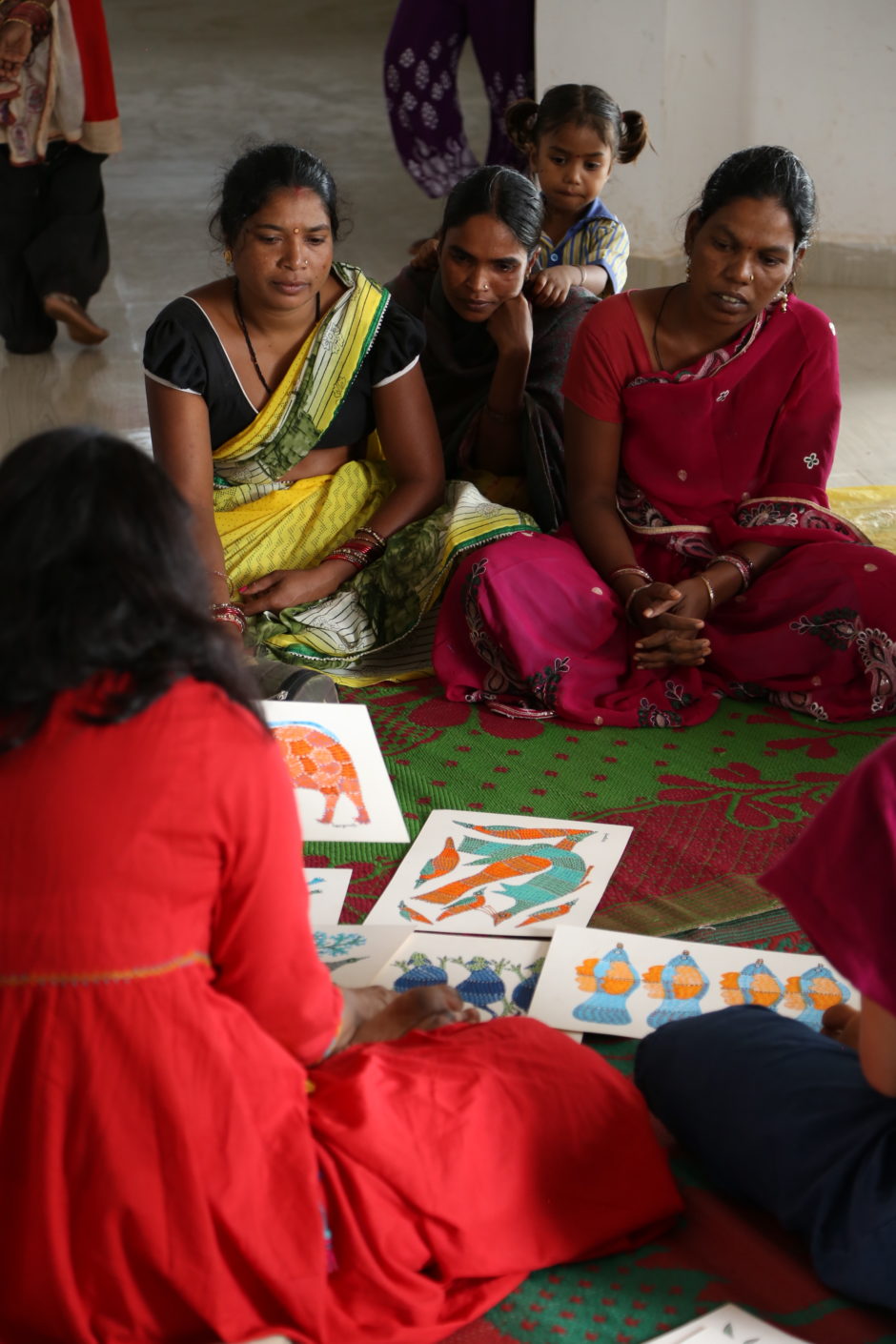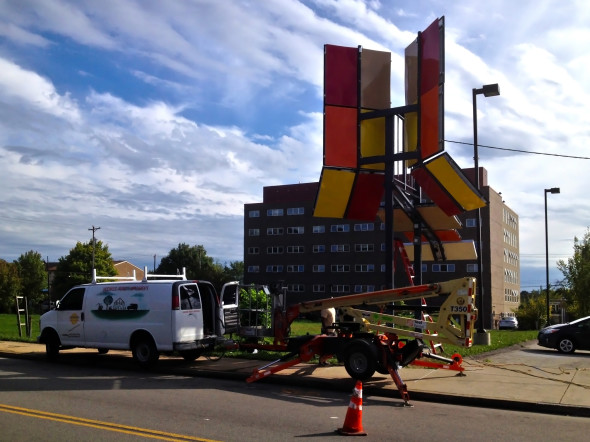story and photos by KRISTINE WONG
Every day, a group of artists congregate in their studio on 23rd Street in Richmond. Several of the artists have exhibited in San Francisco, Los Angeles, New York, China, and Japan. Like other artists, they draw, paint, sew, paste, and sculpt, enveloped in deep concentration.
But what sets these artists apart is that they create in a constant, fluid motion. There’s no hesitation when selecting colors, or putting their brush to paper, needle to fabric, or hands to clay. Their freedom generates an industrious atmosphere, as well as one that appears to honor creativity in its most spontaneous form.
These artists are working at the National Institute for Arts and Disabilities (NIAD), a studio and gallery collaborating with developmentally disabled adults since 1982. More recently, NIAD opened its doors to adults with any kind of disability. More than 60 artists from Contra Costa and Alameda Counties currently work at the studio, supported by a group of 20 teachers, all artists themselves.
It’s the artists’ lack of ego, NIAD staff says, that make them so inspiring. “They have no inhibition,” says Gallery Director Brian Stechschulte. “They’re not restrained by those psychological concerns…that’s what makes their work so interesting. It’s raw, it’s immediate, and it’s unrestrained.”
NIAD was the last of four art centers in the Bay Area founded by Elias and Florence Katz, a couple who wanted to provide a place where people with disabilities could lead self-fulfilling lives. The center in San Jose has since closed, but the other two centers — Creative Growth in Oakland and Creativity Explored in San Francisco – are thriving.
NIAD’s gallery has a regular rotation of exhibits showcasing their artists’ work. Past shows have centered on ceramics, beads, and shadow puppets, and collaborations with Richmond High School and Oakland-based California College of the Arts. “The artists here find solutions that you will never think about,” says Andres Cisneros, Studio Manager. “Traditional artists are taught rules – you just have to forget about that here.”
Several of NIAD’s clientele have been practicing art for more than 20 years. One of them, Sylvia Fragoso, 47, is known for her whimsical, colorful pastel work with religious themes. Fragoso, who lives with her parents in San Pablo, doesn’t say much about her art, but the constant smile on her face is a sign of how she feels. One of her large pastel paintings — a bright, symmetrical scene composed of a gallery of angels, checkered squares resembling stained glass, and babies lying underneath – recently sold to a couple from North Carolina. “I like angels,” Fragoso says, who has exhibited her work in Washington, D.C., Belgium, and China.
Fragoso, like all other NIAD artists who sell their work in the organization’s gallery, gift shop and online store – receive 50% of the selling price. The remains stay within the organization to support teaching and operating expenses. This arrangement, says Pat Coleman, Executive Director, enables the artists to have their own money to spend as they wish. The money artists make from their sales does not jeopardize their monthly Social Security benefits for disabled adults, Coleman says, as NIAD pays artists in monthly increments. In addition to the money they make through sales of their work, over a third of NIAD artists get paid for studio jobs ranging from rinsing out brushes to making tea for the teachers and artists.
The studio is divided into three activity areas: painting, fiber arts, and printmaking. Students also make jewelry, ceramics, and sculpture. Teachers work with the artists one-on-one and introduce them to a number of different techniques. Stechschulte says the teachers do not get in the way of the artists’ creativity, nor do they shape or manipulate their work.
“It’s a fragile line,” says Jan Mignaud, who has taught at NIAD for 3 years. Mignaud was working with the studio’s oldest artist, 88-year-old Beverly Trieber, known affectionately as “Bubba.” The collages, paintings, and prints he produced in the past 20 years at NIAD were featured in a retrospective exhibit last year alongside those of fellow artist Rosie Pardo.
Trieber, wearing a baseball hat festooned with pins and a forest green apron underneath his gold and red 49ers jacket, was designing patches made out of a jumble of recycled silk flowers and scraps of patterned fabric. An array of vintage magazines lay in front of him, where he selected images that would be included on the patches by sticking the pictures to cellophane tape, then sewing them on to the patch. Using a zigzag stitch, he had already sewn several of the patches onto a dark brown apron.
Before coming to NIAD, Trieber was institutionalized for much of his life, which was the norm for people with disabilities born before the late 1970s. Coleman points to Trieber as an example of the effect NIAD has had on the lives of those old enough to have undergone institutionalization. “It’s giving people a chance to lead productive lives,” she says. “They’re developing professional and artistic skills.” In the era of institutionalization, she says, society did not see a role for people who had disabilities, resulting, Coleman says, in the creation of a poor sense of self.
NIAD also sponsors other activities: field trips for artistic inspiration, and independent living classes held during the lunch hour. Many get to the studio by the bus provided by the Regional Center for the East Bay. The Regional Center is the organization that funds a good portion of the daily costs for each developmentally disabled client. The classes are voluntary, as many live with their families and at group homes. But others choose to come on their own through public transit.
Working regular studio hours – some 5 days a week, others just a few days per week — seems to provide a sense of community and friendship.
Harry Ingram and Sarah Malpass were quick to praise each other’s paintings, and eager to pose for a photo together. On a break from working on a cowboy scene in colored pencil and ink — a piece that she said reminded her of a Dean Martin movie — Rosie Pardo munched on half a sandwich. When she saw that another artist didn’t have any food on her table for lunch, she quickly offered to give the other half away.
Stechschulte says what he most enjoys about his job organizing NIAD exhibitions is undermining popular misconceptions about art created by people with disabilities. “People are surprised – they have low expectations,” he says.
Coleman says that NIAD’s model should be replicated in day care centers, nursing homes, and other group homes. “This is the problem with our culture…they don’t have budgets for art. Their way of doing art projects is to keep them busy. But to actually be really creative…wow.”
_______________________________________________________________
This story was originally published on December 23,2009 at Richmond Confidential.

